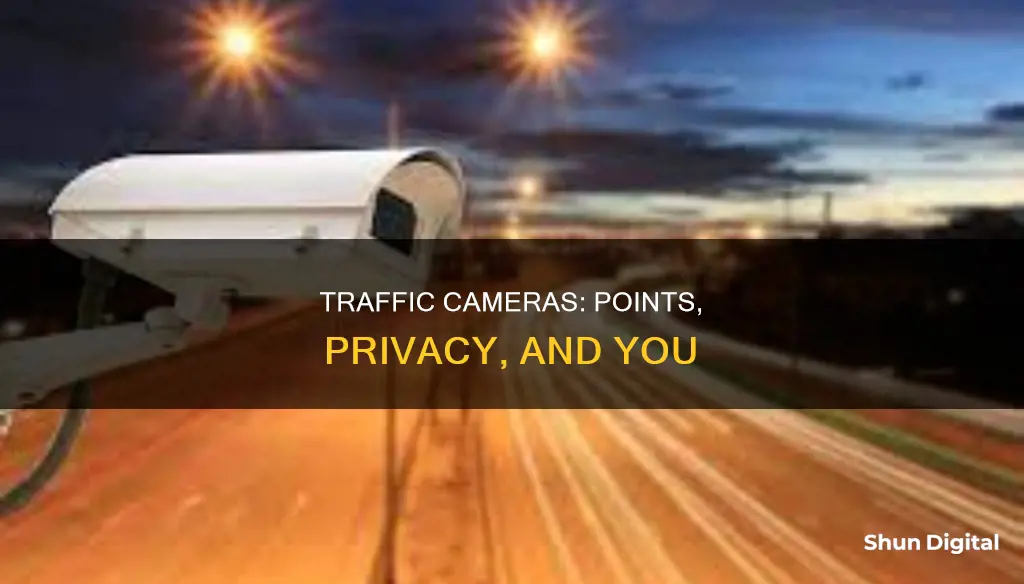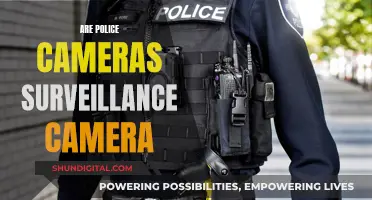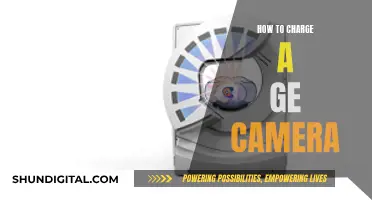
Traffic cameras are a common sight on roads and intersections across the globe, and they serve a variety of purposes, from monitoring traffic conditions to enforcing road rules. While these cameras are typically used to capture evidence of traffic violations such as running red lights or speeding, their impact on a driver's license points can vary depending on the jurisdiction. In most states, traffic camera tickets are treated as non-moving violations, similar to parking tickets, and do not result in points or increased insurance rates. However, a few states, such as Arizona, California, and Oregon, consider them moving violations, which can lead to points and higher insurance premiums. Understanding the specific regulations and potential consequences of traffic camera violations in your area is essential for all drivers.
| Characteristics | Values |
|---|---|
| Purpose | To monitor traffic, detect and issue tickets for violations such as running red lights or speeding |
| Installation Locations | Busy intersections, motorways, busy roads, major junctions, highways, freeways, expressways, arterial roads, temporary traffic lights, school zones, community safety zones |
| Functionality | Captures photos or short video footage (usually triggered by movement), uses sensors or radar technology, connected by optical fibres or powered by solar panels |
| Ticket Consequences | Fine, points on license, increased insurance rates, required educational course |
| Ticket Dispute Options | Provide evidence of no violation, defect in lights/signage, use of dash cam proving false trigger, mitigating circumstances |
What You'll Learn

Traffic camera footage can be used to issue tickets and fines
In most states, tickets from red light or speeding cameras are treated as non-moving violations, similar to parking tickets or tickets for expired registration. As such, they usually do not result in points being added to your driver's license or increases in your car insurance rates. However, there are exceptions. For example, in Arizona, drivers receive two points for red light camera violations and three points for speeding camera violations. California assigns one point for red light camera infractions, while in Oregon, a red light camera ticket is considered a Class B traffic violation.
The process of obtaining traffic camera footage after a car accident can be complex and time-consuming. The footage is typically stored for a limited period, ranging from a few days to several months or even years, depending on the jurisdiction and the specific camera system. To obtain the footage, you need to identify the camera's location and jurisdiction, contact the appropriate agency, and provide details about the accident. In some cases, a subpoena from the court may be required.
While traffic camera footage can be valuable for determining liability and issuing tickets, it has its limitations. These cameras are usually positioned to capture license plates and may not always provide a clear view of the vehicle's interior or the driver's actions. Additionally, the footage is often stored for a limited duration, and privacy concerns surround the retention and usage of such data.
Cameras and Cars: Expensive Attractions Explained
You may want to see also

Footage can be used as evidence in court
Traffic camera footage can be used as evidence in court to support your case and prove your account of events. It can be especially useful in determining liability in the event of an accident, providing proof of important details such as traffic violations or a driver running a red light. This can strengthen your credibility and bolster your case.
Footage can also be used by accident reconstruction experts to determine factors such as the speed of vehicles involved, the sequence of events, and the point of impact. It may also help identify and locate bystanders who witnessed the collision and can provide valuable testimony to support your claim.
In some cases, traffic camera footage may be used to establish liability in an auto accident, especially when liability is disputed. For example, in the case of a T-bone collision, traffic camera footage may show which driver ran the red light, providing clear evidence of liability.
It's important to note that traffic camera footage is not always available or accessible. The process of obtaining footage can be complex and time-consuming, and it may be necessary to involve a lawyer to help secure the evidence. Additionally, footage is typically stored for a limited time, so it's crucial to act quickly if you need access to it.
Fight Traffic Camera Tickets: Ohio-Style
You may want to see also

Cameras are usually placed at busy intersections and junctions
Traffic cameras are often placed at busy intersections and junctions to monitor traffic flow and enforce road safety. These cameras are usually mounted on traffic light poles and use sensors to detect vehicles approaching and moving through the intersection.
Red light cameras, for example, are commonly placed at busy intersections to capture vehicles that enter the intersection against a red light. These cameras are triggered by movement and typically capture a series of photographs or a short video clip of the offending vehicle. The footage is then used as evidence for potential traffic violations, and a citation is mailed to the registered owner of the vehicle.
In addition to enforcing traffic laws, cameras at busy intersections can also help manage traffic congestion. Some intersections with red light cameras also have sensors beneath the road that can adjust the timing of traffic lights based on the volume of traffic. This helps to improve road safety and enhance the flow of traffic.
While red light cameras are typically associated with busy intersections, speed cameras are often placed in less populated areas, such as back roads or residential neighbourhoods, where speeding is a concern. Speed cameras can be fixed, mounted on poles or placed on separate poles next to the road, or mobile, set up by law enforcement and moved around as needed.
Overall, the placement of cameras at busy intersections and junctions serves multiple purposes, including enforcing traffic laws, improving road safety, and facilitating the management of traffic flow.
Rotating Camera on ASUS: Easy Steps to Adjust Your Webcam
You may want to see also

Footage is often stored for a short period of time
The length of time that traffic camera footage is stored varies depending on the jurisdiction and the purpose for which it was recorded. In general, most jurisdictions keep the footage for a period of 30 to 90 days before it is deleted or overwritten. However, there is no standard time frame for storing traffic camera footage, and the storage duration can range from as little as 24 hours to several years.
For example, in New York City, the Department of Transportation stores traffic camera footage for 30 days before it is deleted. On the other hand, traffic camera footage is stored for up to five years in Los Angeles, California. The storage duration of traffic camera footage depends on the policies set by local authorities, as well as the storage technology used.
Some systems use hard drives or solid-state drives with limited storage capacities, which may require frequent deletion or overwriting of old data. In contrast, cloud-based storage solutions offer virtually unlimited storage capacity.
It's important to note that the retention of traffic camera footage also raises privacy concerns. Longer retention periods increase the risk of abuse or misuse of personal information captured by these cameras. Therefore, some jurisdictions have implemented data protection regulations that limit how long personal information can be stored. For instance, under European Union regulations (GDPR), personal data must be deleted after a certain period unless there is a legitimate reason for retaining it.
To address privacy concerns, encryption and access controls can be implemented. By encrypting the data and limiting access to authorized personnel, the risk of unauthorized access or misuse can be reduced.
Overall, the duration of storage for traffic camera footage varies, and there is no consistent timeframe across different locations.
Crafting Camera Batteries: A Step-by-Step Guide
You may want to see also

In some places, traffic cameras do not result in points on your license
Traffic cameras are becoming an increasingly common sight in cities across the United States. While they can serve a variety of purposes, one of their main functions is to monitor and enforce traffic laws, such as running red lights or speeding. These cameras can capture photos or short video footage of vehicles that violate traffic laws, and this footage can be used by law enforcement to issue traffic citations.
It's important to note that even if a traffic camera captures footage of you violating a traffic law, it doesn't automatically mean that you will receive points on your license. In many cases, the local police will simply issue a ticket and a fine. However, if you choose to fight the citation and the footage is used as evidence to establish your violation, it could potentially result in points being added to your license.
Additionally, the impact of a traffic camera citation on your license may also depend on the specific circumstances of the violation. For example, if you are involved in an accident and the traffic camera footage shows that you were at fault, it is more likely to result in points being added to your license compared to a minor traffic infraction.
Overall, while traffic cameras can be a useful tool for enforcing traffic laws and improving road safety, their impact on your driver's license points will depend on the specific laws and regulations in your state, as well as the nature of the violation.
Flying with Camera Gear: Safely Transporting Lithium-Ion Batteries
You may want to see also
Frequently asked questions
Traffic cameras are video cameras that monitor traffic on roads, overseeing general conditions. They are usually placed on major roads and highways, and unlike road safety cameras, they are not part of any law enforcement system.
While local police can use footage from traffic cameras to issue tickets, most of the time, it will not count as a moving violation. Therefore, it typically does not result in points on your license. However, in certain states or situations, such as in Arizona, California, and Oregon, traffic camera footage can be used as evidence in court, potentially leading to points.
Red light cameras are ticket-issuing machines set up at busy intersections to catch drivers who run red lights. They take multiple pictures of the offending vehicle and, in some cases, the driver's face.
Red light cameras themselves do not issue points, but they can result in a ticket and a fine. In most cases, red light camera tickets are treated as non-moving violations, similar to parking tickets. However, in a few states, such as Arizona, California, and Oregon, red light camera tickets are considered moving violations, which can lead to points on your license.
In some cases, you may be able to fight or appeal the ticket. This could involve providing evidence that you did not commit the violation, proving a defect with the lights or signage, or using a dash cam that shows the camera was triggered falsely. Alternatively, you can simply pay the fine, especially if it will not affect your insurance rates or result in points.







